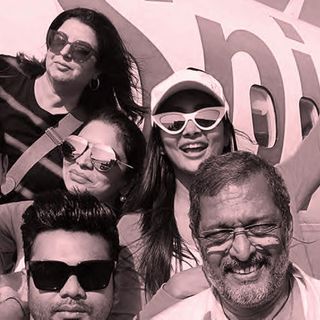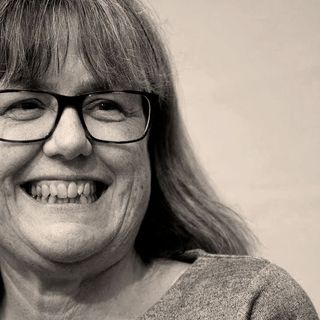
What Happens When Indian Women Cut Their Hair Short
“How could you let this happen?” he asked my husband.

Hair is literally and figuratively an extension of you, serving as a mode of self-expression, reflection and transformation.
Over the centuries, traditional Indian thought has equated long hair with the notions of docility and fertility – qualities high on the list of what a ‘good’ woman should possess. The idea of women spending time grooming their long hair is intertwined with that of the domestic woman who would have the leisure time to care for it.
Long black hair as an ideal of femininity can be seen everywhere from Indian classical painting and sculpture, which depicts women with long hair tied up in neat buns or braids, and in old Bollywood movies which equated open hair with being undressed.
Today, movies have encouraged stereotypes of long wavy hair as essential to womanhood, while short hair is relegated to the subversive or wayward characters. If that’s not enough to get the point across, we are inundated with advertisements for hair products that highlight a woman’s ‘crowning glory’ – long, unrealistically thick, unnaturally lustred hair.
These reigning beliefs have taken root so firmly through classical and popular culture, that snipping off hair has become unthinkable for many.
For me, it was something I mentally prepared for and gradually worked towards over years, going shorter and shorter with each haircut. And yet, finally getting the spikey pixie cut I’d worked towards felt like I was surrendering feminine beauty for brash experimentation.
Although my new look was well-supported by my husband, it met initial surprise from my mother — and has continued to befuddle my father. However, the most startling reaction I received recently was from a male acquaintance who, on seeing my new cut for the first time, roared to my husband, “How could you let this happen?”
If a woman’s hair is a part of her femininity and her attractiveness to men, what does it mean if she decides to cut it off? It’s unfortunate that, for many people, an act that is ultimately liberating for women, is seen as threatening – to a patriarchal society that functions within rigid gender representations.
***
Adhuna Bhabani, Founder and Creative Director of BBLUNT, echoes the hesitancy most women feel. “… people enter our salons and say, ‘Right, I want something new and exciting!’ and then immediately follow it up with ‘but I want to keep the length’…. I would hang up my scissors if I could convince every woman in the land to walk into a salon, shout ‘Gimme short!’ and dance out feeling liberated!”
However, Reema Jose, 38, was one of those few people who didn’t impose any length restrictions when getting her haircut this March. “It had soared to 36 degrees [Celsius],” she recalls. “I was never gladder about my haircut!”
Jose observed that her hair grows back “super fast” – underlining the transience of hair length. Although she redoubled her victory over convention with another haircut in June, for most, breaking away from straitjacketing beauty standards remains an uphill battle.
Although some people may feel that shorter styles don’t suit their facial structure, others may just be more comfortable blending in and not rocking the boat of convention too much. But for Nairita Mukherjee, a 30-year-old who regularly experiments with varying hair lengths,“[My] long hair was sexier, but short hair is cool.”
Her statement highlights the dichotomy women grapple with, and the trap the male gaze sets for them. Although some are able to break away from it, falling back into the trap seems almost inevitable. As 29-year-old Butool Jamal says, “There are so many sexy women with short hair (Zoe Kravitz!)…[but] sometimes, I do have to remind myself of that…”
This perception – that I often subscribe to as well – is one of the reasons women continue to toe the traditional line. Manasvi Savla, co-owner of Mumbai’s indie Pearl Beauty Salon, says, “Most of my clients want styled hair, but reiterate that they want to keep length untouched.”
***
Another issue that women have to grapple with, is that beauty is inextricably tied to youthfulness.
In her seven-year career as a hairstylist, Savla can’t recollect more than a couple of clients who have chosen to let their hair grey naturally. “The rest, between 45 and 65, approximately, ask to cover up their white hair with color,” she says.
BBLUNT’s Babhani has noticed this, too. “There is a large ‘grey coverage’ demand. Because Indian hair is naturally so dark, any single white hair can be seen, it stands out, and a majority of people do want to cover them up.” She continues, “There are a few, however, like myself, who don’t mind the grey hairs coming through….”
59-year-old Dona Prabhune is one of these few. She observes, “In a corporate or private job, dyeing hair is essential nowadays…. Everyone is after me to colour my hair… [but natural hair] suits my face, and one is automatically respected: people get up and offer you a seat in public transport and so on. I look at the bright side of ageing.”
Septuagenarian Asha Kapadia, who cut her hair short in her 20s and kept it that way for decades, chose to cover her greys when they began to appear in her 50s. Now 71, she says she’s set in her ways: “I am not going natural; my younger friends also encourage me to color my hair.”
Interestingly, both these older women wear their hair short. While Kapadia says she keeps it short “to look beautiful!” and Prabhune’s Roman Catholic community views her clipped length as regular fare, there may be another perspective hiding in the shadows – one that sexualizes older women to a lesser degree than younger ones.
This view seems to have permeated our collective psyche to the extent that we’ve been conflating short hair with the idea that it’s less attractive. Of course, it’s not just women who are made to think this. Anand Harlalka admits, “Long is definitely more feminine at first glance, [but] short hair comes across as cute, too.”
Unpacking the societal pressure and conditioning we’ve accumulated over our lifetime is a Sisyphean battle. But there are some small victories we can rejoice over.
30-year-old Mukherjee, who has already begun to notice greys, says, “I’m actually looking forward to when I’ll be as grey as Storm from X-Men! With age, one is supposed to grey. If it’s happening naturally, then let it. I might [become] all white [and add] an aqua blue highlight.”
This sense of playful acceptance may not be easily subscribed to just yet, but we’re gradually heading in the right direction. There’s always hope for a time when external beauty becomes what it should be at the most – an extension of our inner selves.
Suchita Parikh-Mundul likes attaching helpful descriptors to nouns. For instance, she's a half-baked writer, pseudo poet, full-time bibliophile and serial vacationist. She also enjoys creating her own vocabulary, so that's 'vacationist,' explained. She's worked with print magazines and websites, and published a book of poetry (juvenilia) a long, long time ago. She currently freelances as a writer and copy editor.
Related


Bollywood Doesn’t Just Protect Predators, It Produces A Culture That Glorifies Them
